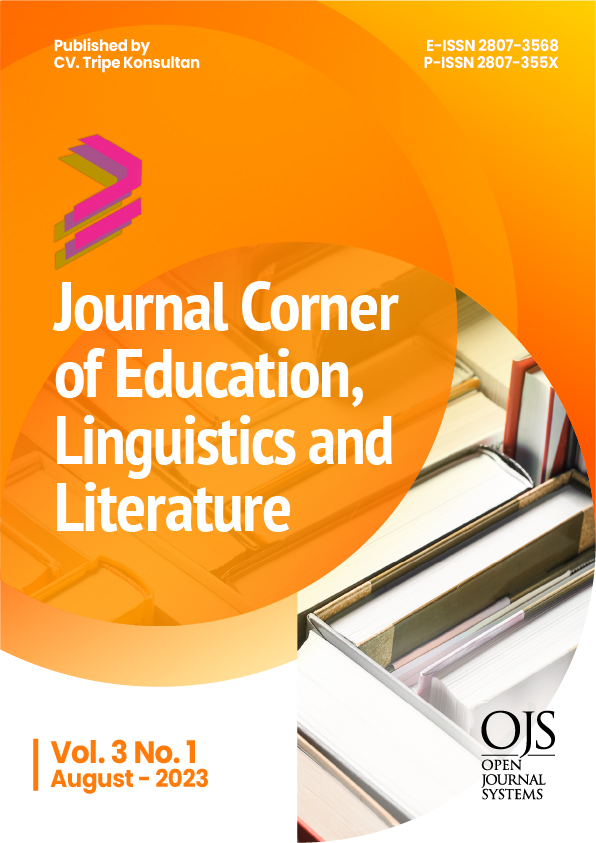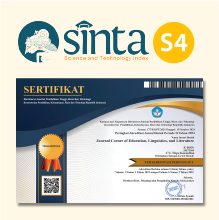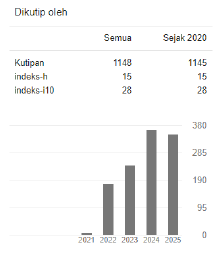Morphology Process and Categorization of Village Names in Warunggunung District Lebak Regency Banten Province
 https://doi.org/10.54012/jcell.v3i1.159
https://doi.org/10.54012/jcell.v3i1.159
 Abstract views: 398
Abstract views: 398
 PDF downloads: 268
PDF downloads: 268
Keywords:
Toponymy, Morphological Process, VillageAbstract
The writing is the names of villages in the Warunggunung district, Lebak Regency, Banten Province. This research aims to describe the morphology, toponym categorization and meaning of village names in Warunggunung district. The research is a descriptive qualitative method with interview and observation techniques in the form of recording and note techniques. The results of the study show that; 1) The names of villages in the Warunggunung district beginning of word pasir and ci- based on their shape were formed through a composition process as many 37 village name starting with ci-. Formed through the abbreviaton process as many as 14 village names;and 2) The toponym category of the village in Warunggunung district consists of (1) embodiment aspect, 44 village names: (a) waters, (b) appearance of the earth, (c) natural environment of flora, fauna, and abiotik (d) flora and appearance of the earth (e) waters and appearance (f) waters and building, (2) community aspect, 2 village names, (a) community leaders (b) community activitaes, and (3) cultural asapect, 5 village names: (a) foklore (b) traditional musical instrument and (c) belief.
Downloads
References
Chaer, A. (2009). Pengantar Semantik Bahasa Indonesia. Jakarta: Rineka Cipta.
Fatkullina, F., et.al. (2022). Toponyms as units of cultural and linguistics transfer: A linguistic and cultural. Journal of Language and Linguistics Studies, 18(2), 884-890.
Hamidah, N. dkk. (2016). Kampung Sebagai Model Permukiman Berkelanjutan di Indonesia. INERSIA, 12(2), 114-124.
Jannah, W., Sulistyowati, N., & Jayanti, A. (2021). Toponimi Kecamatan di Kabupaten Jember. Widyaparwa, 49(1), 81-91.
Koeswinarno. (2015). Memahami Etnografi Ala Spradley. Jurnal SMaRT 1(2), 257-265.
Kridalaksana. (2009). Pembentukan Kata dalam Bahasa Indonesia. Jakarta: Gramedia.
KBBI Daring Edisi V. (2022). Badan Pengembangan Bahasa dan Perbukuan, Kementrian Pendidikan dan Kebudayaan Republik Indonesia.
Lalira, J.E. (2022). Toponymy at garden names at Lahu village. Phonologie: Journal of Language and Literature, 2(2), 230-241.
Muhyidin, A. (2017). Kearifan Lokal dalam Toponimi Di Kabupaten Pandeglang Provinsi Banten: Sebuah Penelitian Antropolinguistik. Jurnal Pendidikan Bahasa dan Sastra, 17(2), 232-240.
Moleong, L.J. (2015). Metodologi Penelitian Kualitatif. Bandung: PT Remaja Rosdakarya.
Muslich, M. (2008). Tata Bentuk Bahasa Indonesia Kajian Ke Arah Tatabahasa Deskriptif. Jakarta: Bumi Aksara.
Pateda, M. (2010). Semantik Leksikal (Edisi Kedua). Jakarta: Rineka Cipta.
Prihadi. (2015). Struktur Bahasa Nama Pedusunan (Kampung) di Daerah Istimewa Yogyakarta: Kajian Antropolinguistik. LITERA, 14(2), 307-316.
Saputri, A.P., et.al. (2020). Asal-usul Nama Kecamatan Sambutan di Kota Samarinda: Tinjauan Antropolinguistik. Ilmu Budaya: Jurnal Bahasa, Sastra, Seni, da Budaya. 4(2), 188-200.
Setyo, W.F.N., Muryani, C., & Nurhadi. (2022). Toponymic and historiography influences on places naming of villages on Lego district. In 3rd International Conference on Geography and Education (ICGE), KnE Social Sciences, 89-100.
Sibarani, R. (2004). Antropolinguistik: antropologi linguistik linguistik antropologi. Medan: Poda.
Sudaryat, Y. (2014). Makna dalam Wacana (Prinsip-prinsip Semantik dan Pragmatik. Bandung: Yrama Widya.
Sugiyono. (2015). Metode Penelitian Kuantitatif Kualitatif fan R&D. Bandung: Alfabeta.
Triana, H.W., et.al. (2022). Semantics relation of places toponymy: Reflection of Minangkabau Migration in the west coast of Sumatera. Humanus, 21(1), 130-146.
Downloads
Published
How to Cite
Issue
Section
License
Copyright (c) 2023 Sulis Sulastri, Asep Muhyidin, Ilmi Solihat

This work is licensed under a Creative Commons Attribution-ShareAlike 4.0 International License.
All articles published in the Journal Corner of Education, Linguistics, and Literature are licensed under the Creative Commons Attribution-ShareAlike License (CC BY-SA).

















